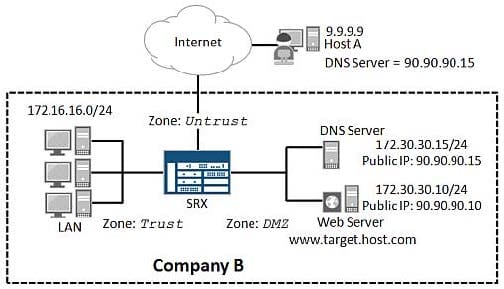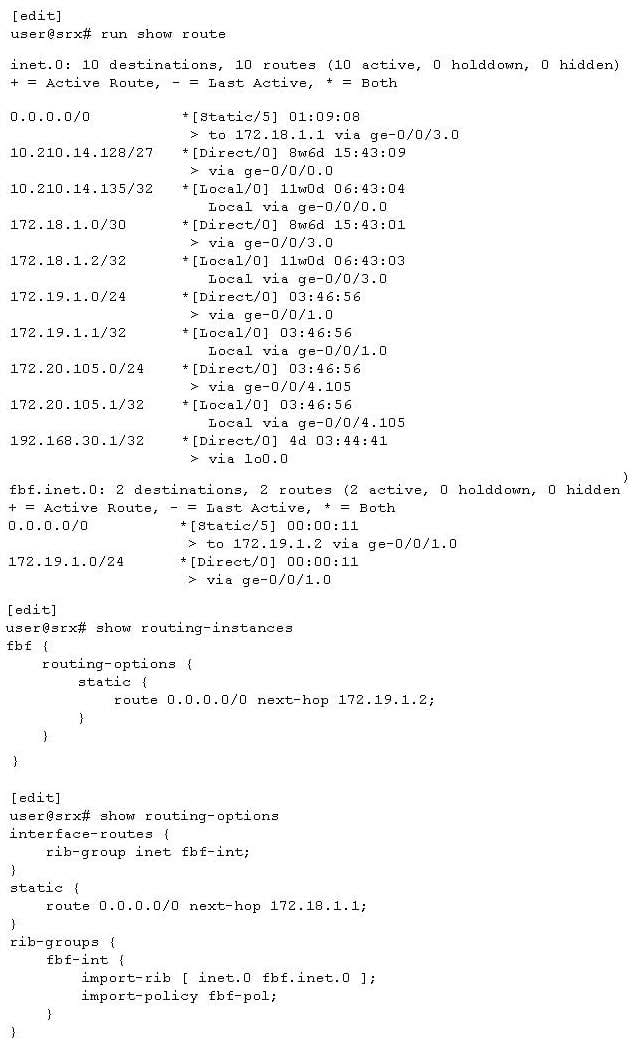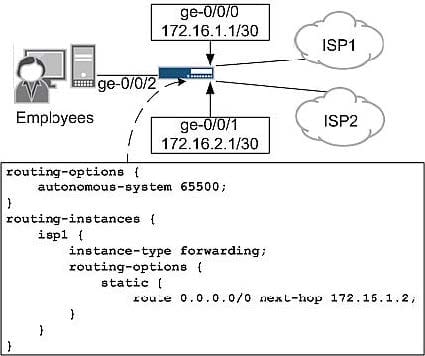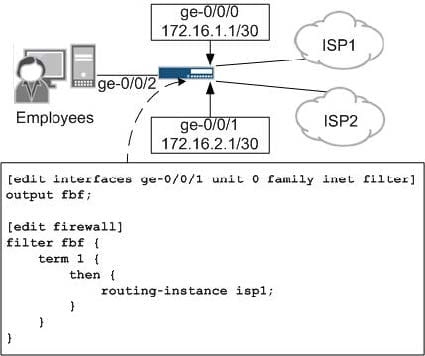Exam Details
Exam Code
:JN0-633Exam Name
:Security, Professional (JNCIP-SEC)Certification
:Juniper CertificationsVendor
:JuniperTotal Questions
:175 Q&AsLast Updated
:Mar 30, 2025
Juniper Juniper Certifications JN0-633 Questions & Answers
-
Question 81:
-- Exhibit -security { nat { destination { pool Web-Server {
address 10.0.1.5/32;
}
rule-set From-Internet {
from zone Untrust; rule To-Web-Server {
match { source-address 0.0.0.0/0; destination-address 172.16.1.7/32;
} then { destination-nat pool Web-Server; } } }
}
}
zones {
security-zone Untrust {
address-book {
address Web-Server-External 172.16.1.7/32;
address Web-Server-Internal 10.0.1.5/32;
}
interfaces {
ge-0/0/0.0;
}
}
security-zone DMZ {
address-book {
address Web-Server-External 172.16.1.7/32;
address Web-Server-Internal 10.0.1.5/32;
}
interfaces {
ge-0/0/1.0;
}
}
} } -- Exhibit -
You are migrating from one external address block to a different external address block. You want to enable a smooth transition to the new address block. You temporarily want to allow external users to contact the Web server using both the existing external address as well as the new external address
192.168.1.1.
How do you accomplish this goal?
A. Add address 192.168.1.1/32 under [edit security nat destination pool Web-Server].
B. Change the address Web-Server-Ext objects to be address-set objects that include both addresses.
C. Change the destination address under [edit security nat destination rule-set From-Internet rule To-Web-Server match] to include both 172.16.1.7/32 and 192.168.1.2/32.
D. Create a new rule for the new address in the [edit security nat destination rule-set From- Internet] hierarchy.
-
Question 82:
Click the Exhibit button.
Based on the output shown in the exhibit, what are two results? (Choose two.)
Exhibit:

A. The output shows source NAT.
B. The output shows destination NAT.
C. The port information is changed.
D. The port information is unchanged.
-
Question 83:
Click the Exhibit button.
You must configure two SRX devices to enable bidirectional communications between the two networks shown in the exhibit. You have been allocated the 172.16.1.0/24 and 172.16.2.0/24 networks to use for this purpose.
Which configuration will accomplish this task?
Exhibit:

A. Use an IPsec VPN to connect the two networks and hide the addresses from the Internet.
B. Using destination NAT, translate traffic destined to 172.16.1.0/24 to Site1's addresses, and translate traffic destined to 172.16.2.0/24 to Site2's addresses.
C. Using source NAT, translate traffic from Site1's addresses to 172.16.1.0/24, and translate traffic from Site2's addresses to 172.16.2.0/24.
D. Using static NAT, translate traffic destined to 172.16.1.0/24 to Site1's addresses, and translate traffic destined to 172.16.2.0/24 to Site2's addresses.
-
Question 84:
Click the Exhibit button.
Referring to the topology shown in the exhibit, which two configuration tasks will allow Host A to telnet to the public IP address associated with Server B? (Choose two.)
Exhibit:

A. Configure transparent mode to bypass the NAT processing of Server B's public IP address.
B. Configure a stateless filter redirecting local traffic destined to Server B's public IP address.
C. Configure a destination NAT rule that matches local traffic destined to Server B's public IP address.
D. Configure a source NAT rule that matches local traffic destined to Server B's public IP address.
-
Question 85:
Click the Exhibit button.
You are asked to implement NAT to translate addresses between the IPv4 and IPv6 networks shown in the
exhibit.
What are three configuration requirements? (Choose three.)
Exhibit:

A. Disable SYN checking.
B. Enable IPv6 flow mode.
C. Configure proxy ARP.
D. Configure stateless filtering.
E. Configure proxy NDP.
-
Question 86:
Click the Exhibit button.
Host A cannot resolve the www.target.host.com Web page when using its configured DNS server. As shown in the exhibit, Host A's configured DNS server and the Web server hosting the www.target.host.com Web page are in the same subnet. You have verified bidirectional reachability between Host A and the Web server hosting the Web page.
What would cause this behavior on the SRX device in Company B's network?
Exhibit:

A. DNS replication is enabled.
B. DNS doctoring is enabled.
C. DNS replication is disabled.
D. DNS doctoring is disabled.
-
Question 87:
Click the Exhibit button.
Referring to the exhibit, you notice that filter-based forwarding is not working. What is the reason for this behavior?
Exhibit:

A. The RIB group is configured incorrectly.
B. The routing policy is configured incorrectly.
C. The routing instance is configured incorrectly.
D. The default static routes are configured incorrectly.
-
Question 88:
Click the Exhibit button.
In the network shown in the exhibit, you want to forward traffic from the employees to ISP1 and ISP2. You want to forward all Web traffic to ISP1 and all other traffic to ISP2. However, your configuration is not producing the expected results. Part of the configuration is shown in the exhibit. When you run the show route table isp1 command, you do not see the default route listed.
What is causing this behavior?
Exhibit:

A. The autonomous system number is incorrect, which is preventing the device from receiving a default route from ISP1.
B. The device is not able to resolve the next-hop.
C. The isp1 routing instance is configured with an incorrect instance-type.
D. The show route table isp1 command does not display the default route unless you add the exact 0.0.0.0/0 option.
-
Question 89:
Click the Exhibit button.
In the network shown in the exhibit, you want to forward traffic from the employees to ISP1 and ISP2. You want to forward all Web traffic to ISP1 and all other traffic to ISP2. While troubleshooting, you change your filter to forward all traffic to ISP1. However, no traffic is sent to ISP1.
What is causing this behavior?
Exhibit:

A. The filter is applied to the wrong interface.
B. The filter should use the next-hop action instead of the routing-instance action.
C. The filter term does not have a required from statement.
D. The filter term does not have the accept statement.
-
Question 90:
Click the Exhibit button.
Referring to the exhibit, which feature allows the hosts in the Trust and DMZ zones to route to either ISP, based on source address?
Exhibit:

A. source NAT
B. static NAT
C. filter-based forwarding
D. source-based routing
Related Exams:
JN0-102
Internet Associate, Junos(JNCIA-Junos)JN0-104
Junos, Associate (JNCIA-Junos)JN0-105
Junos, Associate (JNCIA-Junos)JN0-1101
Juniper Networks Certified Design Associate (JNCDA)JN0-130
Juniper networks Certified internet specialist.e(jncis-e)JN0-1301
Data Center Design, Specialist (JNCDS-DC)JN0-1302
Data Center Design Specialist (JNCDS-DC)JN0-1331
Security Design, Specialist (JNCDS-SEC)JN0-1332
Security Design, Specialist (JNCDS-SEC)JN0-1361
Service Provider Design Specialist (JNCDS-SP)
Tips on How to Prepare for the Exams
Nowadays, the certification exams become more and more important and required by more and more enterprises when applying for a job. But how to prepare for the exam effectively? How to prepare for the exam in a short time with less efforts? How to get a ideal result and how to find the most reliable resources? Here on Vcedump.com, you will find all the answers. Vcedump.com provide not only Juniper exam questions, answers and explanations but also complete assistance on your exam preparation and certification application. If you are confused on your JN0-633 exam preparations and Juniper certification application, do not hesitate to visit our Vcedump.com to find your solutions here.